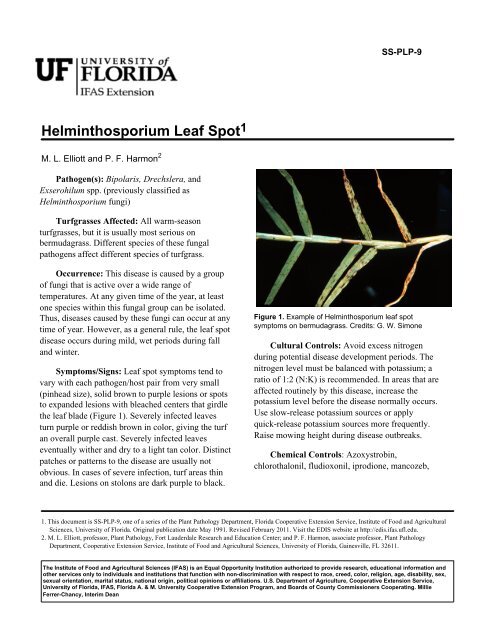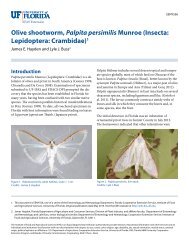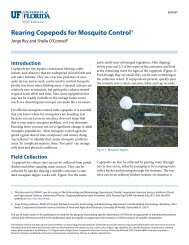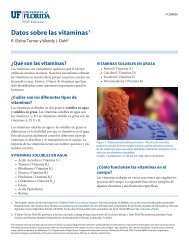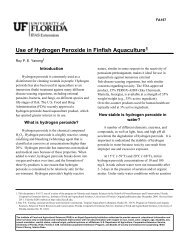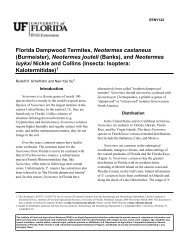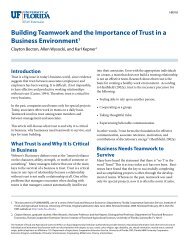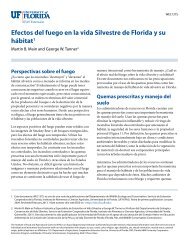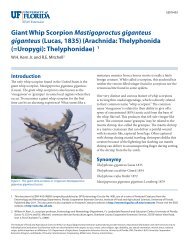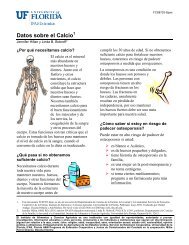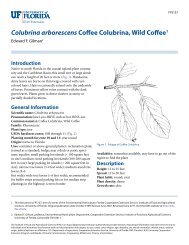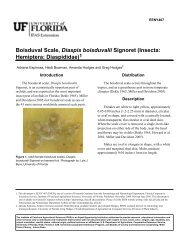Helminthosporium Leaf Spot - EDIS - University of Florida
Helminthosporium Leaf Spot - EDIS - University of Florida
Helminthosporium Leaf Spot - EDIS - University of Florida
Create successful ePaper yourself
Turn your PDF publications into a flip-book with our unique Google optimized e-Paper software.
<strong>Helminthosporium</strong> <strong>Leaf</strong> <strong>Spot</strong> 1<br />
M. L. Elliott and P. F. Harmon 2<br />
Pathogen(s): Bipolaris, Drechslera, and<br />
Exserohilum spp. (previously classified as<br />
<strong>Helminthosporium</strong> fungi)<br />
Turfgrasses Affected: All warm-season<br />
turfgrasses, but it is usually most serious on<br />
bermudagrass. Different species <strong>of</strong> these fungal<br />
pathogens affect different species <strong>of</strong> turfgrass.<br />
Occurrence: This disease is caused by a group<br />
<strong>of</strong> fungi that is active over a wide range <strong>of</strong><br />
temperatures. At any given time <strong>of</strong> the year, at least<br />
one species within this fungal group can be isolated.<br />
Thus, diseases caused by these fungi can occur at any<br />
time <strong>of</strong> year. However, as a general rule, the leaf spot<br />
disease occurs during mild, wet periods during fall<br />
and winter.<br />
Symptoms/Signs: <strong>Leaf</strong> spot symptoms tend to<br />
vary with each pathogen/host pair from very small<br />
(pinhead size), solid brown to purple lesions or spots<br />
to expanded lesions with bleached centers that girdle<br />
the leaf blade (Figure 1). Severely infected leaves<br />
turn purple or reddish brown in color, giving the turf<br />
an overall purple cast. Severely infected leaves<br />
eventually wither and dry to a light tan color. Distinct<br />
patches or patterns to the disease are usually not<br />
obvious. In cases <strong>of</strong> severe infection, turf areas thin<br />
and die. Lesions on stolons are dark purple to black.<br />
SS-PLP-9<br />
Figure 1. Example <strong>of</strong> <strong>Helminthosporium</strong> leaf spot<br />
symptoms on bermudagrass. Credits: G. W. Simone<br />
Cultural Controls: Avoid excess nitrogen<br />
during potential disease development periods. The<br />
nitrogen level must be balanced with potassium; a<br />
ratio <strong>of</strong> 1:2 (N:K) is recommended. In areas that are<br />
affected routinely by this disease, increase the<br />
potassium level before the disease normally occurs.<br />
Use slow-release potassium sources or apply<br />
quick-release potassium sources more frequently.<br />
Raise mowing height during disease outbreaks.<br />
Chemical Controls: Azoxystrobin,<br />
chlorothalonil, fludioxonil, iprodione, mancozeb,<br />
1. This document is SS-PLP-9, one <strong>of</strong> a series <strong>of</strong> the Plant Pathology Department, <strong>Florida</strong> Cooperative Extension Service, Institute <strong>of</strong> Food and Agricultural<br />
Sciences, <strong>University</strong> <strong>of</strong> <strong>Florida</strong>. Original publication date May 1991. Revised February 2011. Visit the <strong>EDIS</strong> website at http://edis.ifas.ufl.edu.<br />
2. M. L. Elliott, pr<strong>of</strong>essor, Plant Pathology, Fort Lauderdale Research and Education Center; and P. F. Harmon, associate pr<strong>of</strong>essor, Plant Pathology<br />
Department, Cooperative Extension Service, Institute <strong>of</strong> Food and Agricultural Sciences, <strong>University</strong> <strong>of</strong> <strong>Florida</strong>, Gainesville, FL 32611.<br />
The Institute <strong>of</strong> Food and Agricultural Sciences (IFAS) is an Equal Opportunity Institution authorized to provide research, educational information and<br />
other services only to individuals and institutions that function with non-discrimination with respect to race, creed, color, religion, age, disability, sex,<br />
sexual orientation, marital status, national origin, political opinions or affiliations. U.S. Department <strong>of</strong> Agriculture, Cooperative Extension Service,<br />
<strong>University</strong> <strong>of</strong> <strong>Florida</strong>, IFAS, <strong>Florida</strong> A. & M. <strong>University</strong> Cooperative Extension Program, and Boards <strong>of</strong> County Commissioners Cooperating. Millie<br />
Ferrer-Chancy, Interim Dean
<strong>Helminthosporium</strong> <strong>Leaf</strong> <strong>Spot</strong> 2<br />
myclobutanil, propiconazole, pyraclostrobin,<br />
trifloxystrobin, triticonazole, and vinclozolin<br />
For a homeowner's guide to turfgrass fungicides,<br />
see http://edis.ifas.ufl.edu/document_pp154. Check<br />
fungicide labels for site application restrictions, as<br />
some fungicides cannot be used on residential lawns.<br />
DMI (demethylation-inhibiting) fungicides have<br />
shown the potential to damage bermudagrass turf.<br />
Follow label directions and restrictions for all<br />
pesticides. The presence <strong>of</strong> a fungicide on this list<br />
does not constitute a recommendation.<br />
Refer to the "Turfgrass Disease Management"<br />
section <strong>of</strong> the <strong>Florida</strong> Lawn Handbook<br />
(http://edis.ifas.ufl.edu/lh040) for explanations <strong>of</strong><br />
cultural and chemical controls.


